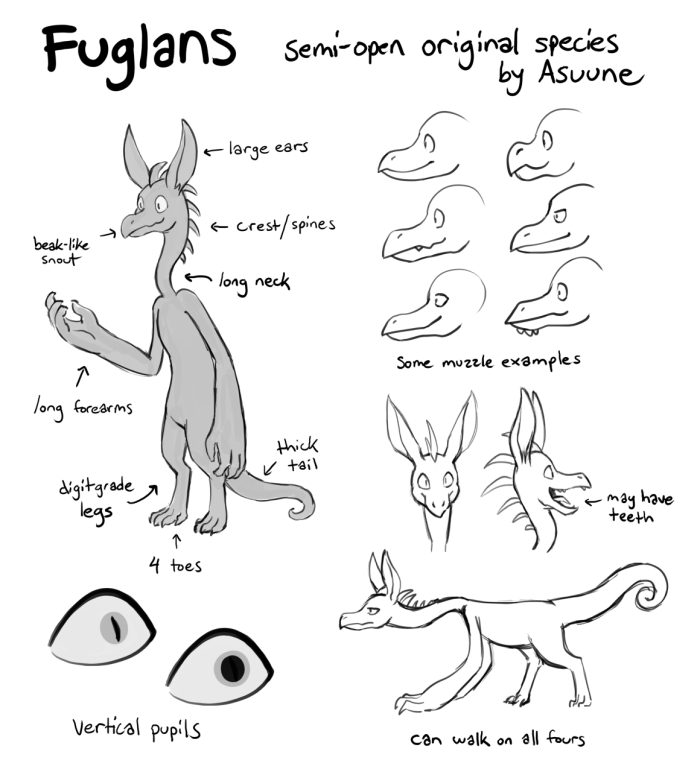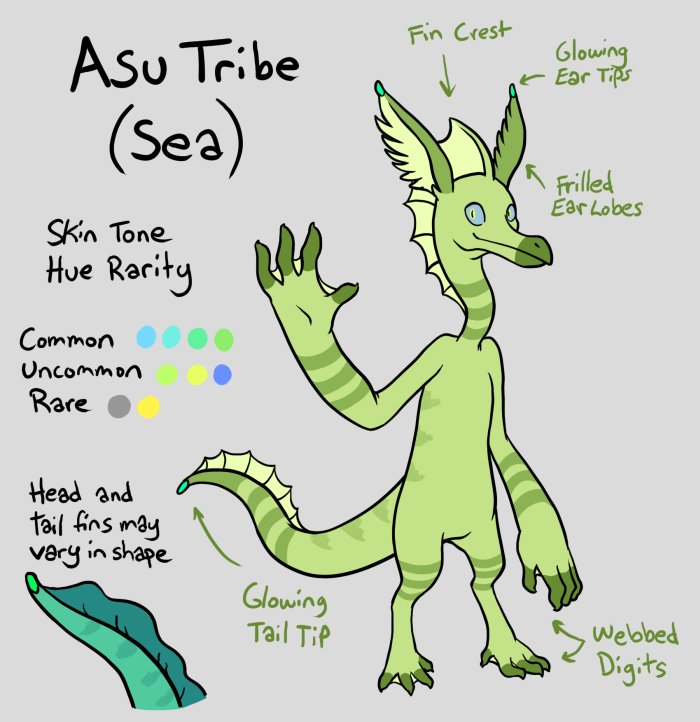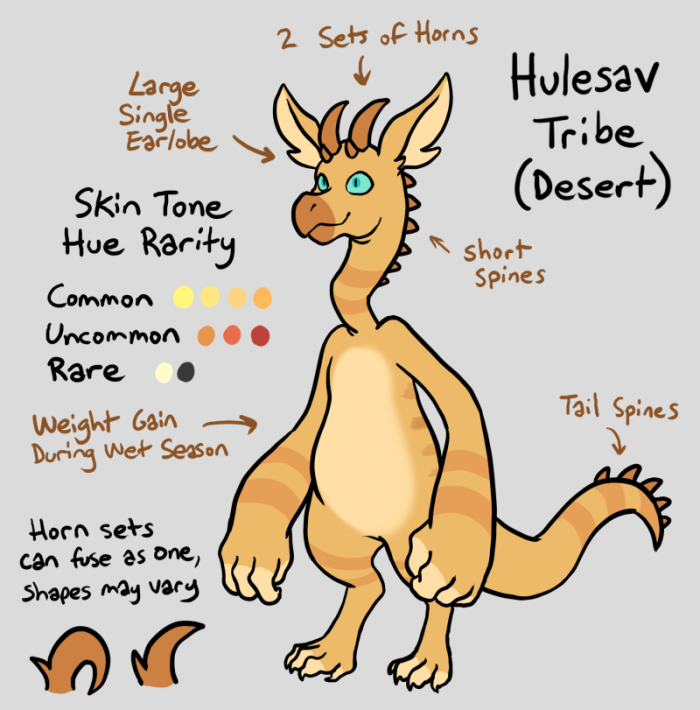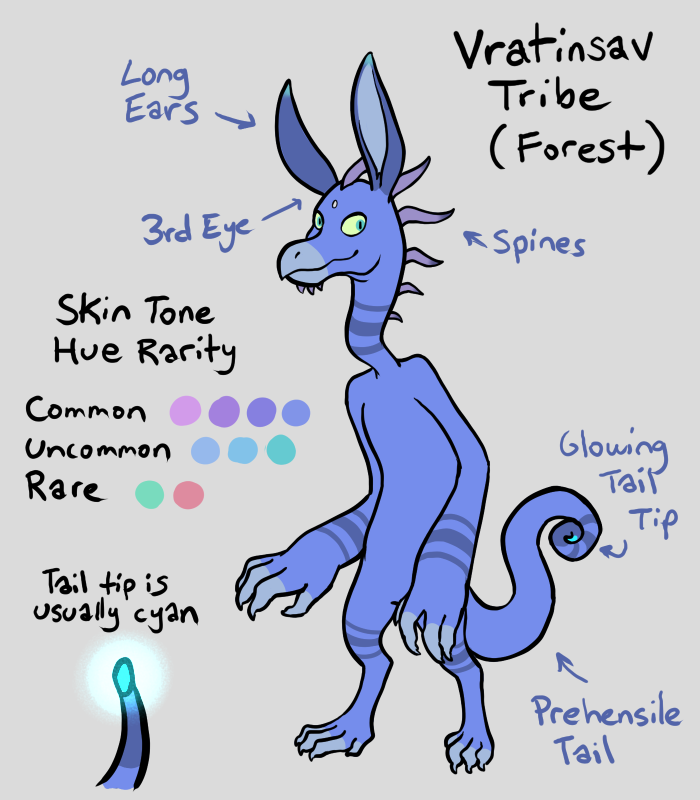
Fuglans
General Information
Fuglans are a sapient reptilian species that live on the Earth-like planet Alaruk. Their species is split into several subspecies known as tribes, which have evolved to adapt in different environments. Tribes are further split into various clans, which may consist of entire villages. Although uncommon, fuglans may crossbreed between tribes with overlapping biomes and clan territories. As cold-blooded creatures, they thrive in warm climates but struggle with cold temperatures.
Culture: Being cold-blooded creatures, fuglans do not need to eat much, but this comes with a trade-off. Fuglans abhor wasting energy and resources and tend to only do the bare minimum to survive. Going to war is considered one of the biggest wastes of energy, which is why it is better to simply avoid it. Ecosystems may provide natural borders against other tribes, but due to the nomadic lifestyles of many clans, this makes it impossible to enforce. Slavery is frowned upon, as fuglans are also uncooperative when forced to do labor, especially outside of their own clan. It is easier to be collectivist and share labor and resources rather than fight and hoard.
Technology: Fuglan technology varies between each clan. The most advanced technology places fuglankind at the Chalcolithic Age, but most civilizations live in Mesolithic to Neolithic lifestyles. Because mining is so laborious, metal is rare and mainly used for jewelry and refinement tools.
Religion: Many clans are spiritual, revering ancestors, spirits, and celestial bodies. Temples and shrines are often built in honor of beloved elder ancestors. Fuglan shamans, known as a ruksala, will be responsible for speaking with spirits and using their magic to help their clan.
Physical description: Semi-bipedal reptilians with large forearms and opposable thumbs. Their necks are long and bird-like and they sport large hare-like ears. Their skin can vary in color, from dull to bright and colorful, depending on the subspecies.
Average lifespan: 120 years
Average height: 5 feet (150 cm)
Average weight: 100 lbs (45 kg)
Diet: Omnivore. Diet varies with subspecies. Fuglans cannot chew their food and rely on gastroliths. They cannot digest grains or dairy. Their diets may include: Meat, insects, fish, shellfish, eggs, fruit, leafy greens, tubers, flowers, herbs, spices, mushrooms, seaweed, honey, seeds, tree nuts, and algae.
Reproduction: Oviparous. Fuglans lay one egg per clutch, about once every 2-4 years, with a 50/50 chance of being male or female. They reach adulthood at around 20 years old.
Abilities: Excellent hearing. Vision is ultraviolet to red, capable of seeing in low-light but not complete darkness. Some subspecies have bioluminescence and extrasensory abilities.
Weaknesses: Cold-blooded. Fuglans cannot survive in cold climates. Tribes are specialized to stay mostly in their own biome.

General fuglan traits.
Tribes
There are seven officially known tribes, however there are other obscure, lesser known kinds of fuglans as well.
Asu
Sea fuglans. They are the largest and most diverse tribe, and inhabit most warm climate areas of Alaruk where there is access to the sea. They tend to build their villages near the coast or in lagoons, or travel on the sea in boats. Their villages are highly varied from clan to clan, making use of coral, drift wood, bamboo, and hemp rope as materials.
Asu can hold their breath up to half an hour, allowing them to dive underwater to fish and scavenge the sea floor. Their ears, which are covered in several sensitive lobes, are able to detect the faintest changes in the atmosphere, making them useful navigators and weather detectors. They have bioluminescent bulbs on the tip of their tails and ears to see in lowlight areas underwater.
Their diet normally consists of saltwater fish, shellfish, crustaceans, spices, seaweed, fruit, and other various plants and critters they can manage to find on land.

Hulesav
Desert fuglans. Their resistance to dehydration make it easier for them to live in arid areas. Their villages are often constructed from sandstone, bricks, mud, and hay. Some clans are semi-nomadic and relocate if drought goes on for too long.
During the wet season, when food is more plentiful, Hulesav will put on more fat and burn it off throughout the dry season. Being heavyset is considered a beauty standard for Hulesav. Being diurnal, they have no bioluminescence.
Their diet normally consists of meat, tubers, fruit, spices, insects, and edible cacti/succulents.

Nidez
Cave fuglans. Villages are built entirely underground and often secluded from most other tribes, with the exception of Udlagudrak clans. Stone, wood, and leather are used to make private dwellings. Bones from their deceased relatives are used for tools, jewelry, and home decoration.
Because this tribe has evolved to live underground, their eyes are much more sensitive to sunlight. They are often leucitic or albino, making it difficult to travel outside during the day without protective clothing or they risk blindness, burning, and sun sickness. Nidez have large bioluminescent bulbs on their tails, as well as smaller bulbs on whisker-like appendages on their chin or muzzle.
Their diet consists of fungus, insects, fish, crustaceans, tubers, and algae.

Rekrrasav
Grassland fuglans. Rekrrasav are nomadic and travel with the seasons, following herds of kariags as a source of food, materials, and mounts. Instead of building settlements, they use wood, leather, and bone to set up temporary shelters.
One of the few diurnal fuglans, Rekrrasav lack any bioluminescence. Their long slender bodies make them efficient sprinters on all fours, able to chase down prey.
Their diet consists mostly of meat, insects, fruit, leafy greens, flowers, and wild tubers.
Udlagudrak
Volcano fuglans. These fuglans make their homes in small cavities in the sides of cliffs and mountains, usually where there is some volcanic activity. They may also share their living spaces with cave fuglans, visiting the surface to find food and nesting materials. Udlagudrak lives are simple and their homes are minimalistic, as they frequently move each year to a new location.
This tribe is the smallest in stature, only 80-100 cm in height, and the only tribe can glide. They have a patagia between their arms and legs, as well as a wide membraine along the length of their tail to allow gliding. They are capable of climbing trees and cliffs, using geothermic vents for extra lift.
Their diet mostly consists of insects, eggs, small animals, and leafy greens.
Vihrrasav
Wetland fuglans. Members of this tribe live in wetlands, rivers, and lakes. Villages are built on pilings in swamps and next to riverbeds. Homes and boats are constructed out of bamboo, hemp, and wood.
Vihrrasav are the only tribe of fuglans that lack legs, instead slithering like a snake. They have two fins on their head that merges into a single fin that goes along the entire length of their spine, to the tip of their light-tipped tail.
Their diet consists of freshwater fish, shellfish, insects, tubers, mushrooms, and leafy greens.

Vratinsav
Forest fuglans. They tend to be more secluded than other fuglan tribes, but usually have good relationships with nearby clans. Their villages are often constructed from wood, hemp, bamboo, and thatch, although they try to leave larger trees untouched and integrate them into their villages.
Vrantinsav are one of the oldest fuglan tribes. They have prehensile tails for grasping onto branches, a visible parietal eye on their forehead, and a bioluminescent bulb on the tip of their tail. They are also more sensitive to spiritual energy and each clan will have at least one ruksala to commune with ancestral spirits.
Their diets normally consist of fruit, tubers, leafy greens, flowers, spices, mushrooms, fish, eggs, and small animals.

Aslauk
This is less of a tribe and more of a classification of fuglans that includes hybrids of other tribes. The term aslauk can be considered derogatory towards hybrids from non-hybrids, but this depends on the context in which it is used.
Because Asu is the most widespread tribe across Alaruk, the majority of aslauk tend to be half Asu. It's not uncommon for Aslauk fuglans to band together to form their own clans, and some of these include pirate bands.
Back to Home
© Asuune 2023-2024